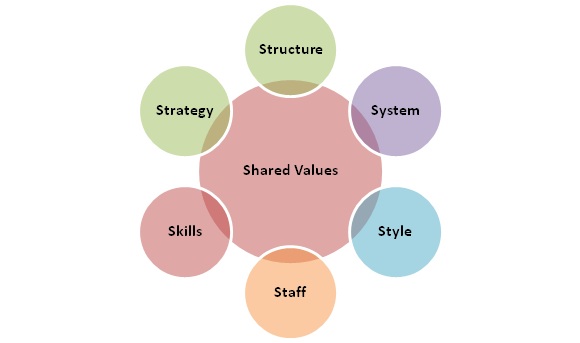7-S Framework McKinsey - Definition & Components
What is 7-S Framework McKinsey?
The McKinsey 7-S framework is a popular model used in organizations to analyze the environment to investigate if the company is achieving its intended objectives. The name of the McKinsey 7 S framework model can be explained by the fact that the model was developed by Tom Peters & Robert Waterman, consultants at the McKinsey & Company consulting firm and it consists of 7 S which are strategy, structure, systems, shared values, skills, style and staff.
Components of McKinsey 7-S Framework
The McKinsey 7-S Framework model proposes 7 interdependent factors – 3 hard ‘S’ i.e. strategy, structure, systems; and 4 soft ‘S’ i.e. shared values, skills, style and staff.
The hard ‘S’ are more tangible, easily to define and easy to influence than the soft ‘S’.
The diagram below shows the McKinsey 7S Framework components.

1. Strategy
It refers to the intended sequence of actions taken by a company to achieve its goals and objectives. It deals with resource allocation and includes competition, customers and the environment.
2. Structure
It refers to how the various business units are structured and how they communicate with each other. A company’s structure may be centralized or decentralized or may take many other forms depending on the company’s culture and values.
3. Systems
This includes a host of systems within an organization that define its processes and routines. It includes performance appraisal system, financial systems, IT systems etc.
4. Shared values
These are the core values of the company that connect all the other 6 factors. These are the fundamental ideas or guiding principles that lay the foundation of businesses.
5. Skills
These define the core competencies of the employees. Some basic skills which employees must have are leadership, communication management, time management, team management etc.
6. Style
This spans the core beliefs, norms and management style in the organization.
7. Staff
It refers to the number and type of employees in the organization. It is very important for an organization to manage its human capital to create competitive advantage.
Hence, this concludes the definition of 7-S Framework McKinsey along with its overview.
This article has been researched & authored by the Business Concepts Team. It has been reviewed & published by the MBA Skool Team. The content on MBA Skool has been created for educational & academic purpose only.
Browse the definition and meaning of more similar terms. The Management Dictionary covers over 1800 business concepts from 5 categories.
Continue Reading:
What is MBA Skool?About Us
MBA Skool is a Knowledge Resource for Management Students, Aspirants & Professionals.
Business Courses
Quizzes & Skills
Quizzes test your expertise in business and Skill tests evaluate your management traits
Related Content
All Business Sections
Write for Us